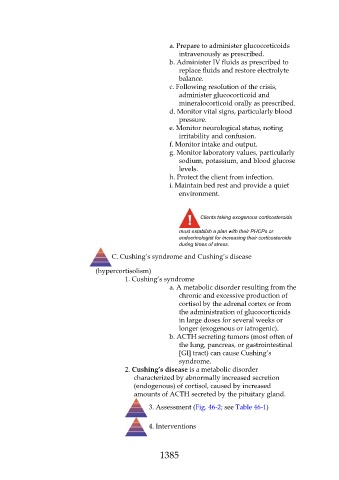Page 1385 - Saunders Comprehensive Review For NCLEX-RN
P. 1385
a. Prepare to administer glucocorticoids
intravenously as prescribed.
b. Administer IV fluids as prescribed to
replace fluids and restore electrolyte
balance.
c. Following resolution of the crisis,
administer glucocorticoid and
mineralocorticoid orally as prescribed.
d. Monitor vital signs, particularly blood
pressure.
e. Monitor neurological status, noting
irritability and confusion.
f. Monitor intake and output.
g. Monitor laboratory values, particularly
sodium, potassium, and blood glucose
levels.
h. Protect the client from infection.
i. Maintain bed rest and provide a quiet
environment.
Clients taking exogenous corticosteroids
must establish a plan with their PHCPs or
endocrinologist for increasing their corticosteroids
during times of stress.
C. Cushing’s syndrome and Cushing’s disease
(hypercortisolism)
1. Cushing’s syndrome
a. A metabolic disorder resulting from the
chronic and excessive production of
cortisol by the adrenal cortex or from
the administration of glucocorticoids
in large doses for several weeks or
longer (exogenous or iatrogenic).
b. ACTH secreting tumors (most often of
the lung, pancreas, or gastrointestinal
[GI] tract) can cause Cushing’s
syndrome.
2. Cushing’s disease is a metabolic disorder
characterized by abnormally increased secretion
(endogenous) of cortisol, caused by increased
amounts of ACTH secreted by the pituitary gland.
3. Assessment (Fig. 46-2; see Table 46-1)
4. Interventions
1385

